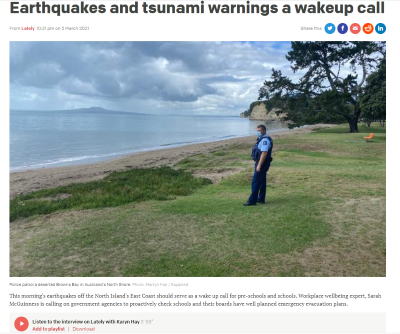Natural disasters aren’t an if – they’re a when. But too often, emergency plans get buried in a drawer and forgotten. I’ve seen how that kind of thinking puts lives at risk. The reality is, even if it’s not your job to create those plans, it still affects you, your colleagues, and your loved ones. Here’s why we all need to be ready.
New Zealand, like much of the Pacific Rim, is no stranger to natural disasters. I’ve lived through the Black Saturday fires in Melbourne in 2009, experienced the aftermath of the Christchurch earthquakes, been woken by the Kaikōura earthquake, and lived with a go-bag ready in Gisborne – where the Hikurangi Subduction Zone, New Zealand’s largest and most active fault, sits poised to shift at any moment, with the potential to trigger a magnitude 9 earthquake.
This past Saturday, I restocked and updated my emergency kit. In Queenstown, experts estimate a 75% probability of an Alpine Fault earthquake occurring in the next 50 years, with a 4 in 5 chance of it being a magnitude 8+ event (AF8.org.nz). That’s sobering. And it reinforces why preparation isn’t optional.
After the Christchurch quakes, people advised keeping sturdy shoes in the car – because in a major disaster, roads could become impassable, and you may have to walk long distances home.
It’s these little things, these lessons learned. From wildfires in California to cyclones in the Philippines, and from Auckland’s floods to Hawke’s Bay’s devastation, preparedness is part of life. Yet, it’s often overlooked or left to chance.

Planning: Everyone’s Business
Emergency planning may not be part of your formal job description, but it should be your business. We all need to know how to stay safe and ensure the right plans are in place – because the consequences of poor planning are too severe to ignore. Here’s an example of why.
In late 2020, our kids’ local Gisborne school announced it would do a hikoi (walk) of its tsunami evacuation route. In theory, this was a great idea. But the school’s location – near the beach, with a hill behind it – meant students would have to cross State Highway 35, one of the most dangerous roads in the region (it’s in New Zealand’s top ten percent for deaths and serious injuries).
During an RNZ interview at the time, I explained, “State Highway 35, for those unfamiliar, is a busy road with trucks traveling at 80km/h. When I looked into the evacuation plan and spoke with teachers, I realised there weren’t enough safety measures to ensure children could cross safely.”
That was putting it politely. The reality? Imagine 250 students and staff gathered at a truck rest area beside a busy highway with teachers in high-vis vests trying to wave down and stop traffic (I kid you not) as kids cross an 80km/h zone. The road curves, limiting visibility, and drivers accelerate after leaving a 60km/h zone. There were no warning signs for motorists.
Studies estimate that in a controlled environment, a car travelling at 80km/hr takes an average of 26m (with new tyres) to 37.6m (with worn tyres) to come to a complete stop. A heavily loaded logging truck would obviously require a greater stopping distance. My heart still stops thinking about it.
After a few phone calls, a local branch of Downer NZ offered free traffic management for the drill. Shockingly, the school initially declined, arguing that such assistance wouldn’t be available in a real emergency. The lack of communication with Waka Kotahi (New Zealand Transport Agency) about 250 children crossing a highway in the middle of the day raised serious concerns as well.
As you can imagine, I wrote a very pointed letter to the school board in the following weeks, urging them to review their procedures. After some back-and-forth, changes were made, but in my view it was far from adequate.
I had a health and safety colleague review the school’s new plan and his reply was, “I’m struggling to know what to make of this. It’s obviously a plan for a drill based on a tsunami threat – rather than THE emergency management plan EMP (for tsunami threat), which I was expecting. So is there a definitive plan for an actual threat? ” Answer = no.
He continued, “I think Risk 7 (interaction with public) is potentially the greatest risk in a real event. I base this on what we saw during the [Christchurch] mosque attacks. Parents behaved (with the best intentions) totally irrationally in many cases. Schools were in lockdown and (mainly) mothers were beating on school doors/windows trying to access their kids. It was chaotic and very distressing for all concerned. In many cases schools decided to breach their lockdowns to let parents into the building.”
“So in this case what are the odds that many parents will turn up, in cars, at the truck stop causing increase vehicle vs person risk. If they take their kids away how do you account for that in a head count etc. This will need some serious consideration in terms of risk management because it’s totally unpredictable. There will also be the added risk of very stressed drivers using the road.”
Here’s a video of the approach to the crossing from the north. This was a weekend day, so no trucks. But on a weekday this road was busy with huge logging trucks.
A Nationwide Issue
That incident prompted me to look deeper into tsunami evacuation planning in schools and found an even bigger problem: schools are responsible for developing their own emergency plans, but no one verifies if they are fit for purpose. While fire evacuation plans must be approved by Fire and Emergency New Zealand, no one checks a school’s disaster management plan. There’s no oversight to ensure these plans align with Civil Defence strategies (which our local school’s plan contradicted). There’s no health and safety sign-off. No one with any authority reviews them to make sure they’re up to scratch.
The school board is responsible, but few people on any school board would have the expertise to design an adequate plan and the Ministry of Education is very hands-off on the whole thing, arguing they provide guidance on a website.
So I surveyed schools nationwide and wasn’t any more reassured. Three preschools told me they would rely on Civil Defence for evacuation advice. But Civil Defence itself warns that in a real tsunami, there may not be time to wait for official instructions. Schools are to make their own plans, and in some cases, those plans are frighteningly inadequate.
And I’m not the first one to identify the problem. In 2017, researchers Tipler and colleagues found that while 91% of schools in New Zealand had developed emergency plans, only 42% had engaged with Civil Defence about any response role the school may have, and only 39% invited emergency preparedness professionals into the school annually.
So I pushed for government agencies to step up, reaching out to the Ministry of Education, the Education Review Office, Civil Defence, NEMA, WorkSafe, and various MPs. The response? A lot of finger-pointing and a bureaucratic runaround that ultimately led nowhere. And I did some press (like the RNZ article) to try and put some pressure on the issue. In the end, for my own sanity, I eventually had to let it go.
Generally speaking, I don’t think schools are at fault. They have a lot on their plates and emergency planning isn’t something most (any?) teachers are trained to do. I do, however, think that the relevant government departments need to invest in resources and expertise to assist schools in developing practical, solid plans.
If you need a tragic example of what happens when a school has a plan but it doesn’t work, read The School Beneath the Wave: The Unimaginable Tragedy of Japan’s Tsunami.
If anything like that ever happens here, you’ll find me incandescent with rage. It’s not like they didn’t know.
Time for Action
This isn’t just about schools – it’s about all workplaces, too. I said it at the time in my RNZ interview, and I’ll say it again: “Once you take a close look at an emergency plan and work through how it would actually play out, you realise there are often major gaps that need fixing.”
Research shows that organisations can strengthen employee resilience and wellbeing by being proactive. A 2017 systematic review by Brooks and colleagues highlighted key factors that shape how employees respond to sudden traumatic events. It’s not just about the immediate reaction – pre-disaster factors like job satisfaction, social support, and organisational readiness all play a major role in how well people cope in the aftermath.
With that in mind, the researchers recommend workplaces:
- Develop clear disaster response policies and train staff properly.
- Build a supportive work environment through strong teams and open communication.
- Identify employees who may be more vulnerable and ensure support systems are in place.
- Train staff in psychological first aid so they can support each other.
- Implement evidence-based resilience programs like Trauma Risk Management (TRiM).
These aren’t just tick-box exercises – the science shows they make a real difference in how well people handle and recover from crises. Without proper preparation, workplaces risk being caught off guard when it matters most.
With recent events reminding us how quickly disaster can strike, we need to take emergency preparedness seriously. Planning ahead can mean the difference between chaos and survival. The question isn’t whether disaster will come – it’s when.
And when it does, will you and your workplace be ready?
Ask to see emergency plans in workplaces, or schools or wherever you spend a lot of time. Most likely people will look at you like you have two heads or you’re overly anxious – but you’re not. Feeling safe and being prepared is vital. My hope is you’ll be reassured that the right plans are in place. At worst, it will be a wake-up call to advocate for proper plans to be put in place.
Here’s some great resources on emergency planning at work:
And for household planning, check out advice from your local authorities. In New Zealand, Civil Defence has great guides on its Get Ready website.
education is the key
A 2016 small-scale study showed that a short emergency planning presentation can significantly boost employees’ views on how well their organisation is prepared for emergencies.
Researchers from Truman State University in Kirksville, Missouri, carried out the study with 82 employees from various workplaces in Northern Missouri. Workers who attended a one-hour educational talk on emergency planning reported feeling their organisation was better prepared compared to those who didn’t attend.
The researchers noted, “Employees who took part in the presentation had a much higher opinion of their organisation’s emergency preparedness level than those who didn’t.”
The study involved 45 employees in a group that attended the presentation and 37 in a control group that didn’t. Both groups completed assessments before and after to measure their emergency planning knowledge and views on organisational preparedness.
While there wasn’t a big difference in emergency planning knowledge between the two groups, those who attended the presentation scored higher on the Crisis/Disaster Preparedness Scale.
The researchers suggest that organisations should include assessments of preparedness levels when educating staff about emergency planning.
They stated, “We recommend that an assessment of organisational preparedness level is added to emergency planning educational presentations. This helps employees immediately apply what they’ve learned and encourages them to get more involved in their organisation’s emergency planning and response.”
The study also found that employees were most familiar with where emergency exits are located but less aware of evacuation plans and strategies for business continuity.
In sum, make a plan, tell people about it, and make sure everyone knows what will happen – and what to do – when disaster strikes.
Source: Renschler, L. A., Terrigino, E. A., Azim, S., Snider, E., Rhodes, D. L., & Cox, C. C. (2016). Employee Perceptions of Their Organization’s Level of Emergency Preparedness Following a Brief Workplace Emergency Planning Educational Presentation. Safety and health at work, 7(2), 166–170. https://doi.org/10.1016/j.shaw.2015.10.001
Additional contributing sources:
Brooks, S. K., Dunn, R., Amlôt, R., Rubin, G. J., & Greenberg, N. (2017). Social and occupational factors associated with psychological wellbeing among occupational groups affected by disaster: a systematic review. Journal of Mental Health, 26(4), 373–384. https://doi.org/10.1080/09638237.2017.1294732
Tipler, K., Tarrant, R., Johnston, D., & Tuffin, K. (2017). Are you ready? Emergency preparedness in New Zealand schools. International Journal of Disaster Risk Reduction, 25, 324–333. https://doi.org/10.1016/j.ijdrr.2017.09.035










